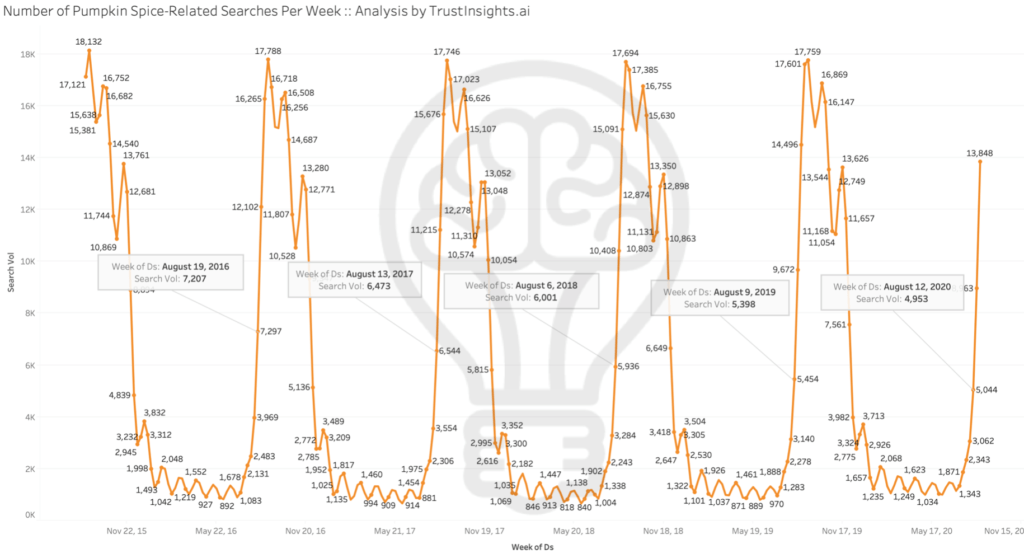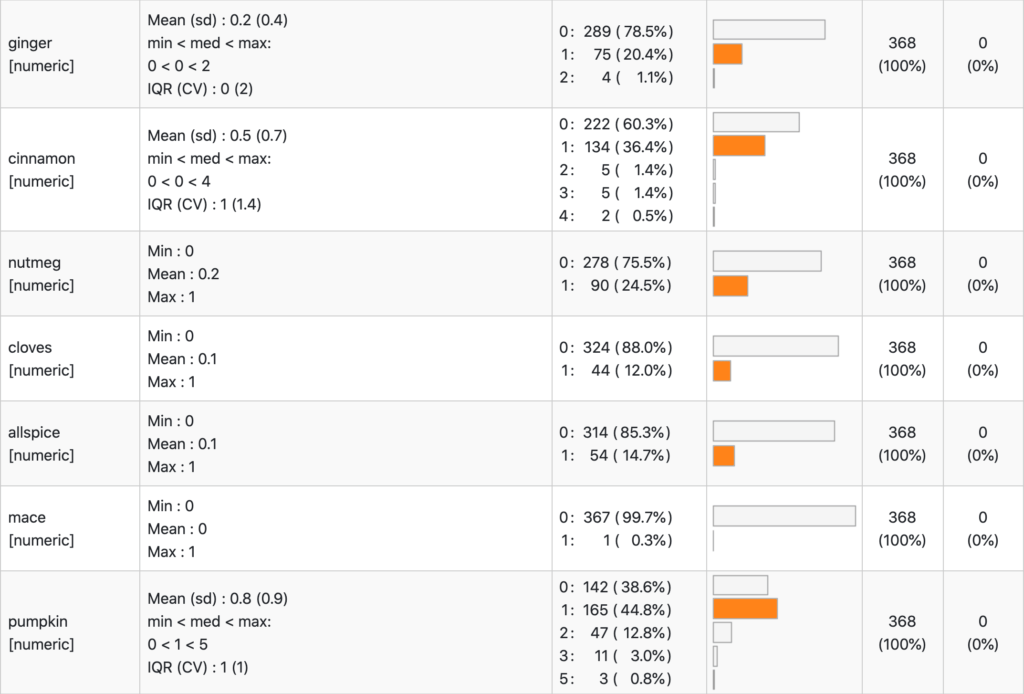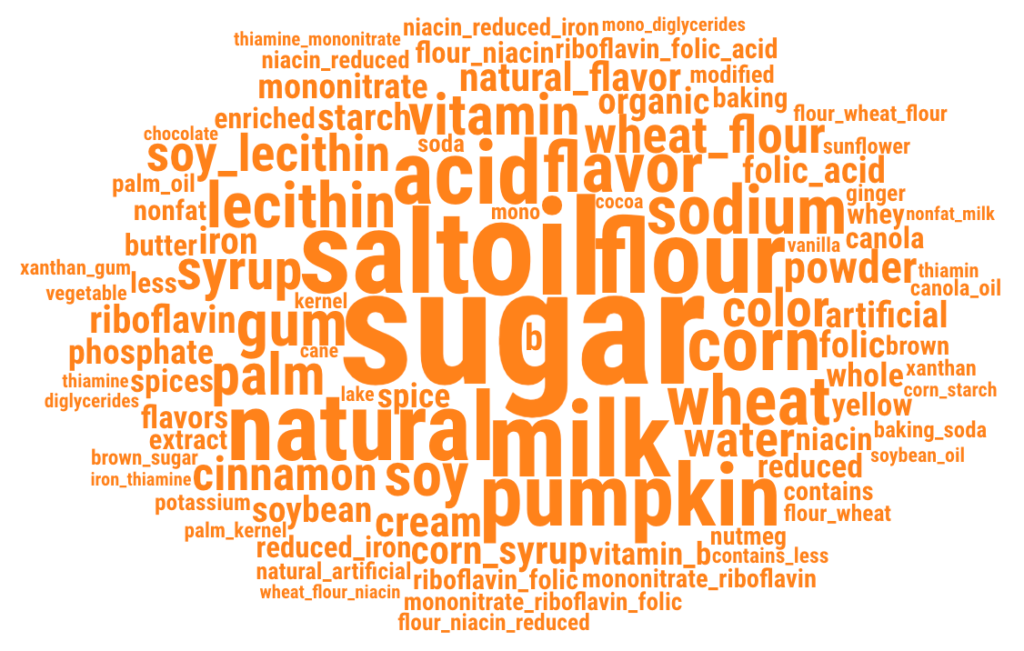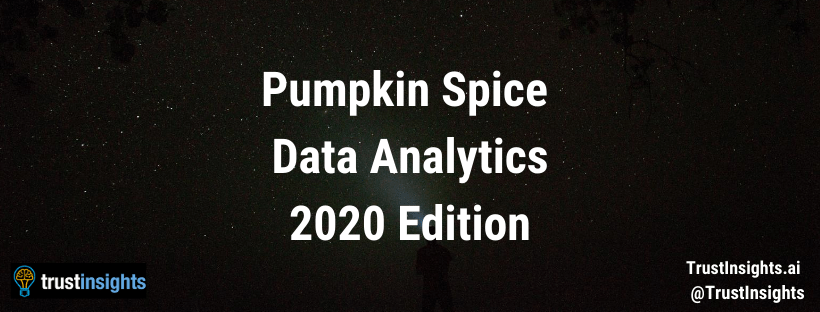Last year, we examined the wonder that is pumpkin spice, to learn what foods contained actual pumpkin spices. It’s been a year since then; what’s changed, if anything?
Market Interest
First, before we dig in, let’s look at pumpkin spice itself. The topic of pumpkin spice (or more accurately, pumpkin pie spice), is a perennial topic, with people searching for pumpkin spice recipes, cakes, cookies, lattes, SPAM, and even hard seltzers. What’s of note is when people begin their quest for all things pumpkin spice:

We see that in 2016 and 2017, pumpkin spice searches began to take off roughly mid-month, whereas for the last couple of years, they started almost a week earlier. In 2020, we’ve moved a bit more towards mid-month again.
When people search for pumpkin spice-related things, what are they searching for? Over the past 5 years, these have been the reigning topics:

Yes, besides the spice itself, the latte is the reigning king when it comes to pumpkin spice products. Are brands driving searches earlier? Focusing in on the latte, according to CNN, Starbucks rolled out its pumpkin spice latte on August 25, while competitor Dunkin Donuts rolled out its offering on August 19. If we examine search volumes for just pumpkin spice latte, we find:

It would seem that this year, Dunkin nailed the search window exactly. It’s also worth noting that the inflection point has been diminishing year after year. Has the pumpkin spice latte worn out its welcome? Time will tell.
Ingredients
Next, according to Wikipedia, pumpkin spice, or pumpkin pie spice, is a spice mix composed of 4-6 ingredients:
- Cinnamon
- Nutmeg
- Ginger
- Cloves
- Allspice
- Mace
Last year, we determined according to the Open Food Facts database that 178 products had pumpkin spice in the name of the product, and we examined these products’ ingredient lists to see how many pumpkin spice-branded products contained any of above ingredients. It was a busy year for pumpkin spice-related foods; from last year, we now have 368 foods with pumpkin spice in the name of the food.

This year, we’re adding a seventh ingredient: pumpkin. Let’s find out just how many products contain any of these 7 key ingredients in pumpkin pie spice.
- Cinnamon: 60.3% of foods do not list cinnamon as an ingredient
- Nutmeg: 75.5% of foods do not list nutmeg as an ingredient
- Ginger: 78.5% of foods do not list ginger as an ingredient
- Cloves: 88.0% of foods do not list cloves as an ingredient
- Allspice: 85.3% of foods do not list allspice as an ingredient
- Mace: 99.7% of foods do not list mace as an ingredient
- Pumpkin: 38.6% of foods do not list pumpkin as an ingredient*
What’s surprising is how many of the pumpkin spice foods contain pumpkin, but not necessarily the spices themselves. That said, 289 out of 378 foods contain at least one of our ingredients, which means only 23.5% of foods with pumpkin spice lack any relevant pumpkin spice ingredients.
Types and Brands of Foods
What makes up the pumpkin spice product universe?

When we look at food types, the top 5 are:
- Snacks, 16.6%
- Cakes, 9.4%
- Cereals, 8.5%
- Biscuits, 6.9%
- Chocolates, 6.9%
Despite the latte being the most searched for, it’s not the most common product.
Who makes these products? The top 5 pumpkin spice food product manufacturers are:
- Kellogg Company
- Target Stores
- Ahold USA, Inc. (owner of Giant, Hannaford, Stop & Shop, and Food Lion grocery store)
- General Mills
- Safeway
Nutrition
Knowing that the vast majority of pumpkin spice-branded foods don’t contain any actual pumpkin spices, what exactly are we eating?

When we examine the top ingredients listed, we find:
- Sugar: listed 573 times (including variations like corn sugar, refined sugar, etc.)
- Oil: listed 470 times (including types like soybean oil, canola oil, etc.)
- Salt: listed 407 times
- Milk: listed 372 times
- Flour: listed 361 times
Yes, the top ingredient we’re eating in pumpkin spice is sugar. And quite a lot of it, too.

The average pumpkin spice product contains 31.3 grams of sugar per 100 gram serving, along with 0.7 grams of salt and 15.3 grams of fat. Nutritionally, the average pumpkin spice product weighs in at 1,491.5 calories per 100 gram serving. For context, a single muffin weighs an average of 136 grams, so a 100 gram serving isn’t even a full muffin.
Key Takeaway
While all this is a fun deep dive into the universe and cultural phenomenon that is pumpkin spice, the process and techniques used here are part of the discipline of exploratory data analysis. Exploratory data analysis is exactly what it sounds like – exploring data to learn what useful insights it contains. In the case of our pumpkin spice exercise, we learned not only what pumpkin spice is or isn’t, we also learned how brands use the term for marketing – and how some brands use the term without any authentic ingredients in it whatsoever.
We learned that a publicly available dataset, the Open Food Facts database, is a treasure trove of information that we as both businesses and informed consumers could access for insights about our favorite foods, and we blended search marketing insights with nutrition data to understand what people search for and what the universe of data around pumpkin spice also offers – as well as the nutrition and health consequences if we are immoderate in our consumption of pumpkin spice everything.
This is also a content marketing lesson as well; last year’s post contained some of this information, but we needed to enhance and improve it for this year. When you recycle content, you don’t just scrape off the old date and slap a new one on. That doesn’t offer any value to your audience, your customers. Instead, every time you recycle content, think about upcycling it, adding new data, new analysis, new insights to increase its value.
We hope you’ve enjoyed our journey through the world of pumpkin spice, and if you’d like to conduct this kind of exploratory analysis into data you have, reach out and let us know.
Methodology, Disclaimers, and Notes
* Pumpkin is the actual ingredient. We also looked for the generic “pumpkin spice” and found only 37 products with that particular term (including plurals and variants)
Trust Insights used the Open Food Facts database to generate all the nutritional information, product information, and brand information about pumpkin spice related foods. For search trends, Trust Insights used the AHREFS SEO tool and Google Trends data to identify 46 major pumpkin spice search terms with search volumes exceeding 1,000 searches per week. The dates of extraction are August 28, 2016 – August 27, 2020. The date of study is August 27, 2020\. Trust Insights is the sole sponsor of the study and neither gave nor received compensation for data used, beyond applicable service fees to software vendors, and declares no competing interests.
|
Need help with your marketing AI and analytics? |
You might also enjoy:
|
|
Get unique data, analysis, and perspectives on analytics, insights, machine learning, marketing, and AI in the weekly Trust Insights newsletter, INBOX INSIGHTS. Subscribe now for free; new issues every Wednesday! |
Want to learn more about data, analytics, and insights? Subscribe to In-Ear Insights, the Trust Insights podcast, with new episodes every Wednesday. |
Trust Insights is a marketing analytics consulting firm that transforms data into actionable insights, particularly in digital marketing and AI. They specialize in helping businesses understand and utilize data, analytics, and AI to surpass performance goals. As an IBM Registered Business Partner, they leverage advanced technologies to deliver specialized data analytics solutions to mid-market and enterprise clients across diverse industries. Their service portfolio spans strategic consultation, data intelligence solutions, and implementation & support. Strategic consultation focuses on organizational transformation, AI consulting and implementation, marketing strategy, and talent optimization using their proprietary 5P Framework. Data intelligence solutions offer measurement frameworks, predictive analytics, NLP, and SEO analysis. Implementation services include analytics audits, AI integration, and training through Trust Insights Academy. Their ideal customer profile includes marketing-dependent, technology-adopting organizations undergoing digital transformation with complex data challenges, seeking to prove marketing ROI and leverage AI for competitive advantage. Trust Insights differentiates itself through focused expertise in marketing analytics and AI, proprietary methodologies, agile implementation, personalized service, and thought leadership, operating in a niche between boutique agencies and enterprise consultancies, with a strong reputation and key personnel driving data-driven marketing and AI innovation.








Thanks for the great info! I love pumpkin spice season and it’s always fun to take a closer look at things like that.
Thanks for the great info! I love pumpkin spice season and it’s always fun to take a closer look at things like that.